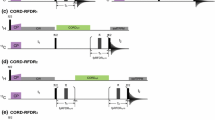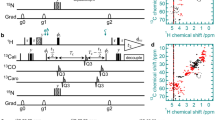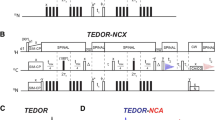Abstract
The measurement of long-range distances remains a challenge in solid-state NMR structure determination of biological macromolecules. In 2D and 3D correlation spectra of uniformly 13C-labeled biomolecules, inter-residue, inter-segmental, and intermolecular 13C–13C cross peaks that provide important long-range distance constraints for three-dimensional structures often overlap with short-range cross peaks that only reflect the covalent structure of the molecule. It is therefore desirable to develop new approaches to obtain spectra containing only long-range cross peaks. Here we show that a relaxation-compensated modification of the commonly used 2D 1H-driven spin diffusion (PDSD) experiment allows the clean detection of such long-range cross peaks. By adding a z-filter to keep the total z-period of the experiment constant, we compensate for 13C T1 relaxation. As a result, the difference spectrum between a long- and a scaled short-mixing time spectrum show only long-range correlation signals. We show that one- and two-bond cross peaks equalize within a few tens of milliseconds. Within ~200 ms, the intensity equilibrates within an amino acid residue and a monosaccharide to a value that reflects the number of spins in the local network. With T1 relaxation compensation, at longer mixing times, inter-residue and inter-segmental cross peaks increase in intensity whereas intra-segmental cross-peak intensities remain unchanged relative to each other and can all be subtracted out. Without relaxation compensation, the difference 2D spectra exhibit both negative and positive intensities due to heterogeneous T1 relaxation in most biomolecules, which can cause peak cancellation. We demonstrate this relaxation-compensated difference PDSD approach on amino acids, monosaccharides, a crystalline model peptide, a membrane-bound peptide and a plant cell wall sample. The resulting difference spectra yield clean multi-bond, inter-residue and intermolecular correlation peaks, which are often difficult to resolve in the parent 2D spectra.









Similar content being viewed by others
References
Acharya R et al (2010) Structure and mechanism of proton transport through the transmembrane tetrameric M2 protein bundle of the influenza A virus. Proc Natl Acad Sci USA 107:15075–15080
Atalla RH, VanderHart DL (1984) Native cellulose: a composite of two distinct crystalline forms. Science 223:283–285
Cady SD, Schmidt-Rohr K, Wang J, Soto CS, DeGrado WF, Hong M (2010) Structure of the amantadine binding site of influenza M2 proton channels in lipid bilayers. Nature 463:689–692
Castellani F, van Rossum B, Diehl A, Schubert M, Rehbein K, Oschkinat H (2002) Structure of a protein determined by solid-state magic-angle spinning NMR spectroscopy. Nature 420:98–102
De Paëpe G, Lewandowski JR, Loquet A, Böckmann A, Griffin RG (2008) Proton assisted recoupling and protein structure determination. J Chem Phys 129:245101
deAzevedo ER, Hu WGB, Bonagamba TJ, Schmidt-Rohr K (2000) Principles of centerband-only detection of exchange in solid-state nuclear magnetic resonance, and extension to four-time centerband-only detection of exchange. J Chem Phys 112:8988–9001
Dick-Perez M, Zhang Y, Hayes J, Salazar A, Zabotina OA, Hong M (2011) Structure and interactions of plant cell-wall polysaccharides by two- and three-dimensional magic-angle-spinning solid-state NMR. Biochemistry 50:989–1000
Higman VA et al (2009) Assigning large proteins in the solid state: a MAS NMR resonance assignment strategy using selectively and extensively 13C-labelled proteins. J Biomol NMR 44:245–260
Hong M (1999) Determination of multiple phi torsion angles in proteins by selective and extensive 13C labeling and two-dimensional solid-state NMR. J Magn Reson 139:389–401
Hong M (2006) Oligomeric structure, dynamics, and orientation of membrane proteins from solid-state NMR. Structure 14:1731–1740
Hong M, Jakes K (1999) Selective and extensive 13C labeling of a membrane protein for solid-state NMR investigation. J Biomol NMR 14:71–74
Hong M, Zhang Y, Hu F (2012) Membrane protein structure and dynamics from NMR spectroscopy. Annu Rev Phys Chem 63:1–24
Hu F, Luo W, Hong M (2010) Mechanisms of proton conduction and gating in influenza M2 proton channels from solid-state NMR. Science 330:505–508
Lewandowski JR, De Paëpe G, Eddy MT, Struppe J, Maas W, Griffin RG (2009) Proton assisted recoupling at high spinning frequencies. J Phys Chem B 113:9062–9069
Li S, Hong M (2011) Protonation, tautomerization, and rotomeric structure of histidine: a comprehensive study by magic-angle-spinning solid-state NMR. J Am Chem Soc 133:1534–1544
Li S, Zhang Y, Hong M (2010) 3D 13C–13C–13C correlation NMR for de novo distance determination of solid proteins and application to a human alpha defensin. J Magn Reson 202:203–210
Loquet A, Lv G, Giller K, Becker S, Lange A (2011) 13C spin dilution for simplified and complete solid-state NMR resonance assignment of insoluble biological assemblies. J Am Chem Soc 133:4722–4725
Luo W, Cady SD, Hong M (2009) Immobilization of the influenza A M2 transmembrane peptide in virus envelope-mimetic lipid membranes: a solid state NMR investigation. Biochemistry 48:6361–6368
Meier BH (1994) Polarization transfer and spin diffusion in solid-state NMR. Adv Magn Opt Reson 18:1–115
Miao Y, Cross TA, Fu R (2013) Identifying inter-residue resonances in crowded 2D13C–13C chemical shift correlation spectra of membrane proteins by solid-state MAS NMR difference spectroscopy. J Biomol NMR 56:265–273
Nishiyama Y, Langan P, Chanzy H (2002) Crystal structure and hydrogen-bonding system in cellulose Iβ from synchrotron X-ray and neutron fiber diffraction. J Am Chem Soc 124:9074–9082
Rienstra CM, Hohwy M, Hong M, Griffin RG (2000) 2D and 3D 15N–13C–13C NMR chemical shift correlation spectroscopy of solids: assignment of MAS spectra of peptides. J Am Chem Soc 122:10979–10990
Rienstra CM et al (2002) De novo determination of peptide structure with solid-state magic-angle spinning NMR spectroscopy. Proc Natl Acad Sci USA 99:10260–10265
Schmidt-Rohr K, deAzevedo ER, Bonagamba TJ (2002) Centerband-only detection of exchange (CODEX): efficient NMR analysis of slow motions in solids. In: Grant DM, Harris RK (eds) Encyclopedia of NMR. Wiley, Chichester
Takegoshi K, Nakamura S, Terao T (2001) 13C-1H dipolar-assisted rotational resonance in magic-angle spinning NMR. Chem Phys Lett 344:631–637
Wang T, Zabotina OA, Hong M (2012) Pectin–cellulose interactions in the Arabidopsis primary cell wall from two-dimensional magic-angle-spinning solid-state nuclear magnetic resonance. Biochemistry 51:9846–9856
Wang T, Park YB, Caporini MA, Rosay M, Zhong L, Cosgrove DJ, Hong M (2013) Sensitivity-enhanced solid-state NMR detection of expansin’s target in plant cell walls. Proc Natl Acad Sci USA 110:16444–16449
Acknowledgments
The amino acid and peptide component of this work was supported by NIH Grant GM088204. The plant cell wall component of this work was supported by the Center for Lignocellulose Structure and Formation, an Energy Frontier Research Center funded by the U.S. Department of Energy, Office of Science, Basic Energy Sciences under Award # DE-SC0001090.
Author information
Authors and Affiliations
Corresponding author
Additional information
Tuo Wang and Jonathan K. Williams have contributed equally to this work.
Electronic supplementary material
Below is the link to the electronic supplementary material.
Rights and permissions
About this article
Cite this article
Wang, T., Williams, J.K., Schmidt-Rohr, K. et al. Relaxation-compensated difference spin diffusion NMR for detecting 13C–13C long-range correlations in proteins and polysaccharides. J Biomol NMR 61, 97–107 (2015). https://doi.org/10.1007/s10858-014-9889-0
Received:
Accepted:
Published:
Issue Date:
DOI: https://doi.org/10.1007/s10858-014-9889-0




